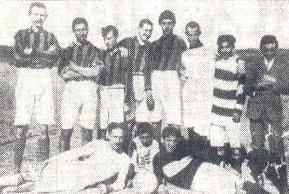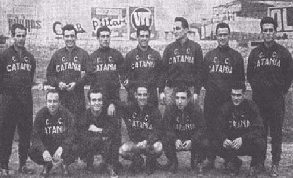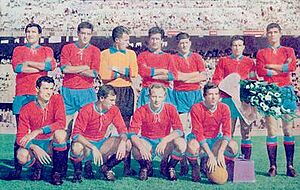Catania FC facts for kids
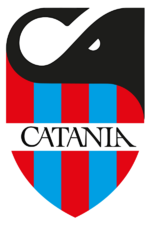 |
||||
| Full name | Catania Football Club s.r.l. |
|||
|---|---|---|---|---|
| Nickname(s) | I Rossazzurri (The Red and Blues) Gli Elefanti (The Elephants) Gli Etnei (The Etneans) |
|||
| Founded | 1929 | |||
| Ground | Stadio Angelo Massimino, Catania, Italy |
|||
| Capacity | 23,266 | |||
| Owner | Elefante 1946 Pty Ltd (Pelligra Group) | |||
| Chairman | Ross Pelligra | |||
| Coach | Domenico Toscano | |||
| League | Serie C Group C | |||
|
||||
Catania Football Club, often called Catania, is an Italian football team. It is based in the city of Catania, which is in Sicily, Italy. The club currently plays in Serie C, one of Italy's professional football leagues.
The club was first started in 1908. It has played 17 seasons in Italy's top league, Serie A. Catania finished in eighth place four times, once in the early 1960s and again in the 2012–13 season. Catania is also one of the most popular teams in Italy, with about 600,000 fans. The club has been restarted a few times, most recently in 2022.
Club History
Early Days of Football (1901–1908)
Football first came to Sicily thanks to English merchant ship crews. The earliest Catania team played a match on May 2, 1901. This game was against Messina Football Club. The Catania team was called Royal Yacht Catania, and it was made up of a ship's crew from Catania.
This ship workers' team was just for fun. Catania's first official football club began on June 19, 1908. It was founded by Gaetano Ventimiglia and Francesco Sturzo d'Aldobrando. They named the club A.S. Educazione Fisica Pro Patria. In the beginning, they often played against sailors visiting the port of Catania. Their very first match was against an Italian battleship, and it ended in a 1–1 draw. Just two years later, the club changed its name to Unione Sportiva Catanese.
Forming the Club (1908–1943)
Football was more organized in northern Italy. Clubs there played in early Italian Football Championships. Southern clubs played in local cups. US Catanese continued playing after World War I. They later played in the local Coppa Federale Siciliana. In 1927, they were promoted to the Campionato Catanese. They won this league in the 1928–29 season.
After this win, the team moved up to the Second Division. However, Italian football rules changed. This led to US Catanese being disbanded. A new club, Società Sportiva Catania, was formed on June 27, 1929. This new club first played in Serie B in the 1934–35 season. They finished fourth that year. Catania played in Serie B for three seasons before moving down a league. In Serie C, Catania won the championship in the 1938–39 season. They finished above their rivals, Siracusa and Messina. The club's name was briefly changed to Associazione Calcio Fascista Catania in the 1942–43 season. This season ended early because of World War II.
Starting Fresh (1945–1949)
After World War II, a local competition called the Campionato Siciliano was held. At the end of that season, a local team called Elefante Catania joined the club. The combined club kept the Catanese name. They played in Serie C during the 1945–46 season. Another team, Virtus Catania, also played in the same league.
After that season, Catanese and Virtus joined together to form Club Calcio Catania. Their first president was Santi Manganaro-Passanisi. The club was promoted to Serie C, where they played for three seasons. After a close race with Reggina, Catania earned promotion to Serie B for the 1948–49 season.
Golden Years (1953–1965)
The late 1950s and 1960s are known as the golden years for Catania. During this time, they were promoted to Serie A twice. Their first promotion from Serie B happened in the 1953–54 season. They won the division, beating teams like Cagliari. In their first Serie A season, they finished a good 12th place. However, the club was later moved down a league due to financial issues.
Under coach Carmelo Di Bella, Catania was promoted from Serie B again in the 1959–60 season. Catania returned to Serie A for the 1960–61 season. They stayed in the league for six years. The newly promoted club finished eighth, above big Italian clubs like Lazio and Napoli. This season brought many important wins. They beat Napoli and Bologna twice. They also beat Sampdoria 3–0 at home. Most famously, they beat Milan 4–3 in Sicily. On the last day of the season, they beat Internazionale 2–0.
Four years later, in 1965, Catania again finished eighth in the league. This time, they were above Roma and their Sicilian rivals Messina. Many of the club's best players played during this time. These included midfielders Alvaro Biagini and the Brazilian Chinesinho. Wingers Carlo Facchin and Giancarlo Danova were also key players. Catania won against Juventus (2–0), Fiorentina (2–0), and Lazio (1–0).
Challenges and Comebacks (1966–2006)
After Catania moved down a league in 1966, Carmelo Di Bella left. The club stayed in Serie B for a while. They were promoted back to Serie A in 1969–70 after finishing third. However, they only stayed in Serie A for one season. In that season, they had a 3–1 win against Lazio. They also drew at home against Milan.
In 1973–74, they moved down to Serie C. But they quickly earned promotion back to Serie B by winning the championship. A similar thing happened in 1976–77. They moved down to Serie C again, but then won the championship of what was now called Serie C1 in 1979–80.
After three short seasons, Catania was promoted to Serie A. They finished third, behind Milan and Lazio. They played the 1983–84 season in Italy's top league. They only won one game that season, against Pisa.
More Ups and Downs (1985–2006)
After their last move down to Serie B, Catania faced more challenges. The team could no longer reach the top division. Instead, they continued to play in Serie C1 for many years. In 1993, the team was temporarily removed from the league by the Italian Football Federation (FIGC) due to some problems with rules.
After a court decision, Catania was allowed back into football. They were placed in the Sicilian Eccellenza, which was the sixth level of Italian football. Meanwhile, another team, Atletico Leonzio, moved to Catania and changed its name to Atletico Catania. Despite these challenges, the original Catania team quickly moved back up to Serie C. They then returned to Serie B in 2002.
In 2003, Catania was part of a big discussion that led to Serie B growing from 20 to 24 teams. This was known as Caso Catania. The club argued that an opposing team used a player who wasn't allowed to play. This situation caused delays and protests from other clubs. Eventually, the Italian government stepped in.
The league was reduced to 22 teams for the 2004–05 season. At the same time, Serie A grew from 18 to 20 teams. In 2004, Antonino Pulvirenti bought the club. His new ownership helped the team improve. In 2005–06, Catania finished second in Serie B. This earned them a promotion to Serie A.
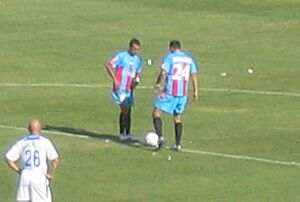
Back in Serie A (2006–2013)
The 2006–07 season was Catania's first time in Serie A in 22 years. In their first year back, they played very well at home. They even reached fourth place after 20 games.
However, their season changed on February 2, 2007, due to an incident during a match. This happened during the Sicilian derby against Palermo. The event led to all football games in Italy being stopped for a while. Catania's chairman, Antonino Pulvirenti, even said he wanted to leave football.
After the league restarted, Catania continued playing. They did not win for 12 games in a row. But they beat Udinese 1–0 in late April 2007. They eventually finished 13th that season.
The next season was tougher. Manager Pasquale Marino left, and Silvio Baldini took over. In the Coppa Italia, Catania reached the semi-finals but lost to A.S. Roma. Baldini then resigned, and Walter Zenga became the new coach. Zenga helped the team avoid moving down a league. He was kept as coach for the 2008–09 season.
On June 5, 2009, Zenga left Catania to coach their rival team, Palermo. Gianluca Atzori replaced him. Atzori was known for using an attacking style of play. On December 8, 2009, Siniša Mihajlović became the new head coach. He joined when the club was last in Serie A. His first game was a loss, but the next week, his team beat Juventus 2–1 away from home. After Mihajlović left, Marco Giampaolo became coach for the 2010–11 season. In January 2011, Catania changed coaches again. Diego Simeone took over and helped the team stay in the league. He left after four months. Later, Vincenzo Montella became the coach.
Rolando Maran managed the team in the 2012–13 season. He led Catania to a record-breaking season. They earned 56 points from 38 Serie A matches. This season also saw Catania achieve its highest number of home wins and overall victories in a single top-flight season. They finished ahead of Internazionale. They were only five points away from playing in the UEFA Europa League.
Recent Years and New Beginnings (2013–Present)
Catania moved down from Serie A after the 2013–14 season. They were later moved down to the Lega Pro and had points taken away. During the 2014–15 season, there were issues with some matches.
In July 2020, a group called Sport Investment Group Italia S.p.A. (S.I.G.I.) bought most of the club. However, this deal did not work out. On December 22, 2021, the club was declared unable to pay its debts. After several attempts to find a new owner, the club was officially removed from the 2021–22 Serie C season on April 9, 2022. All players and staff were released.
In June 2022, an Australian businessman named Ross Pelligra was given the right to start a new club. This new club would play in the Italian Serie D. Pelligra promised to invest money to bring Catania back to Serie A. He also showed interest in buying the Torre Del Grifo training center.
The new club was named Catania Società Sportiva Dilettantistica. Ross Pelligra became president, and Vincenzo Grella became vice-president. The club was then allowed to play in the 2022–23 Serie D. Catania finished first in their group in Serie D. This earned them an automatic promotion back into Serie C for the 2023–2024 season.
Team Players
Current Squad
|
|
Players on Loan
|
Stadium and Training
Stadio Angelo Massimino
- Name: Stadio Angelo Massimino
- Location: Catania
- Capacity: 23,420 people
- Opened: November 27, 1937
- Pitch Size: 110 x 70 metres
Catania first played at the Stadio Angelo Massimino in 1937. It was originally called the Stadio Cibali. The stadium was renamed in 2002 to honor former president Angelo Massimino. He was president of the club from 1969 until he passed away in 1996. There have been talks about building a new, larger stadium called Stadio Dèi Palici.
Torre del Grifo Village Sports Center
Catania trains at the Torre del Grifo Village sports center. This center opened on May 18, 2011. It is located in the nearby town of Mascalucia. The center covers a large area and has four football fields. Two fields have natural grass, and two have artificial grass. It also has two swimming pools and four gyms. The main office of Calcio Catania is also located at Torre del Grifo.
Club Achievements
Catania has won several titles throughout its history:
| Competition | Titles |
|---|---|
| Coppa delle Alpi | 1960 (representing FIGC) |
| Competition | Titles |
|---|---|
| Serie B | 1953–54 |
| Competition | titles |
|---|---|
| Prima Divisione | 1933–34 |
| competition | titles |
|---|---|
| Serie C | 1938–39, 1947–48, 1948–49, 1974–75, 1979,80 |
| competition | titles |
|---|---|
| Serie C2 | 1998–99 |
| competition | titles |
|---|---|
| Serie D | 1994–95, 2022–23 |
| competition | titles |
|---|---|
| Eccellenza | 1993–94 |
Important Placings
Catania has also reached important stages in other competitions:
| Coppa delle Alpi | Final |
|---|---|
| Genoa vs Catania | 1964 |
| Coppa Italia | Semifinal |
|---|---|
| Roma vs Catania | 2007–08 |
Club Records
- Highest League Position: 8th place in Serie A (achieved in 1960–61, 1964–65, and 2012–13 seasons).
- Most League Appearances: 281 games by Damiano Morra (1975–1984).
- Most League Goals: 47 goals by Guido Klein and Adelmo Prenna.
- Most Serie A Appearances: 150 games by Giuseppe Vavassori (1961–1966).
- Most Serie A Points: 56 points in the 2012–13 season.
See also
 In Spanish: Catania Football Club para niños
In Spanish: Catania Football Club para niños


